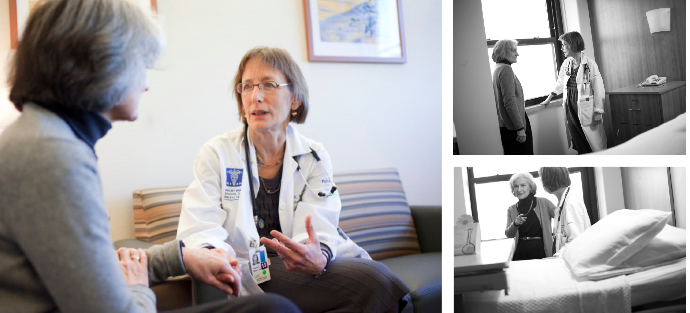CO-FUNDING
CAPC: Forging Partnerships
and Alliances for
Patient-Centered Care
In 2006, the Center to Advance Palliative Care (CAPC) at the Icahn School of Medicine at the Mount Sinai Medical Center was at a crossroads. The Robert Wood Johnson Foundation, CAPC’s sole funder since its launch in 1999, announced it would no longer fund palliative care for the seriously ill.
The issue of sustainability in the face of a funder’s change in strategic direction had suddenly become very real. Under the direction of Diane E. Meier, MD, CAPC had established an evidence-based track record showing that palliative care—specialized medical care that focuses on providing relief from symptoms, pain, and stress for people facing serious illnesses—improves outcomes and reduces costs. The patient-centered approach was also gaining traction in hospitals and health care settings.
Facts: 1,635, or 66 percent of U.S. hospitals with more than 50 beds have a palliative care team—an increase of 148.5 percent since 2000.
76.2 percent of older adults with dementia are hospitalized versus 51.2 percent of equivalently ill older adults without dementing illness.
-Callahan et al
Finding one funder to step in with $10 million to replace the Robert Wood Johnson Foundation’s support simply wasn’t feasible. Having forged a relationship built on mutual trust, Dr. Rieder and Hartford staff counseled Dr. Meier to put together a consortium of funders, and ultimately CAPC was grateful that the Robert Wood Johnson Foundation agreed to provide transitional funding. This helped bring in multiple new funders to the project, with the Hartford Foundation contributing $750,000.
CAPC has thrived by putting together this diverse group of funders whose interests include aging and health, medical research, cancer research, palliative care, support for those
with serious illnesses, and health issues within the New York community, among others.
 Diane E. Meier, MD, Director of the Center to Advance Palliative Care, works to improve access to high quality palliative care to provide relief from symptoms, pain, and stress for people and families facing serious illness.
Diane E. Meier, MD, Director of the Center to Advance Palliative Care, works to improve access to high quality palliative care to provide relief from symptoms, pain, and stress for people and families facing serious illness.
Over the past seven years, CAPC has become as much a partner as a grantee to the Hartford Foundation, building a relationship characterized by clear and frequent communication. Dr. Meier says she and Hartford have forged “a real intellectual partnership,” especially around the issue of aligning palliative care and geriatrics.
Dr. Meier says she consulted with Hartford staff and her fellow grantees as she prepared the Henderson Lecture she delivered at the American Geriatrics Society (AGS) Annual Scientific Meeting in 2013. One of the main points of the lecture was that in order to meet the needs of older adults and their families, geriatrics and palliative care “…need to be speaking with one voice and working together,” she says.
Dr. Meier also credits the Foundation with playing the role of convener in arranging a summit meeting between AGS and the American Academy of Hospice and Palliative Medicine, which led to an agreement to pursue strategic alignment.
“CAPC has taught us about the process of transformational change in health care: the interplay of policy, research, education, communications, finance, and leadership. Most of all, Diane has taught us the value of persistence. We hope to continue our relationship with CAPC long into the future.”
Christopher A. Langston, PhD
Program Director
John A. Hartford Foundation
Steven A. Schroeder, MD, who led the Robert Wood Johnson Foundation when CAPC was launched and was brought back to New York by the Foundation to review its progress, calls
Dr. Meier “one of the national treasures of health care.”
And Dr. Schroeder, now a professor of health and health care at the University of California, San Francisco, says CAPC “…is beginning to mainstream palliative care into the fabric of the hospitals in the United States.”
There is no question that CAPC has delivered results. In 2000, the year after CAPC launched, less than one-quarter of hospitals in the U.S. with 50 or more beds had a palliative care pro- gram. In 2014, eight in 10 U.S. hospitals with 50 or more beds will have a palliative care program.
Having led the foundation that played such an important role in the birth of CAPC,
Dr. Schroeder is pleased by its continuing success. “I’d like to see that every person who needs palliative care can get it, and can get it from high quality, empathic, highly seasoned health professionals,” he says. “I think that’s within our reach.”
Fact: A 2011 study of lung cancer patients found that those receiving palliative care had improved quality of life, less major depression, and even lived longer than those receiving standard, more aggressive care.